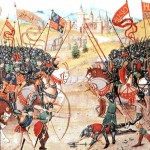 You know the story immortalized by Shakespeare’s Henry V: a small force of scrappy but proud Englishmen (we few, we happy few) beat the arrayed force of French nobility on October 25, 1415, St. Crispin’s Day.
You know the story immortalized by Shakespeare’s Henry V: a small force of scrappy but proud Englishmen (we few, we happy few) beat the arrayed force of French nobility on October 25, 1415, St. Crispin’s Day.
Well, some French historians beg to differ, and they’re holding a conference at the Medieval History Museum in Agincourt on October 25th, the 593rd anniversary of the battle, to rewrite the history the victors claimed.
First, the few:
In fact, detailed bureaucratic records of French king [sic] Charles VI’s army reveal that they were made up of 9000 travelling soldiers, perhaps with another 3000 locals from the Picardy region where the battle took place.
This compares to the total force of 12000 who travelled to France with Henry, although some 3000 were lost during the preceding siege of Harfleur, and through dysentery.
Then, the happy:
Mr Gilliot said notably horrific acts perpetuated by the English included placing prisoners in a barn and setting in [sic] on fire, with the permission of Henry V.
When the Duke of Alençon, who commanded the second division of the French army, had failed to put an axe through Henry, he tried to surrender but was killed by the King’s 40-strong bodyguard.
Forty to one. I like them odds.
No British academics were invited to the conference; I can’t imagine why. This isn’t an exclusively French nationalist revision, though. The article cites a British professor, Anne Curry, who has written a book debunking the pro-England propaganda surrounding Agincourt.